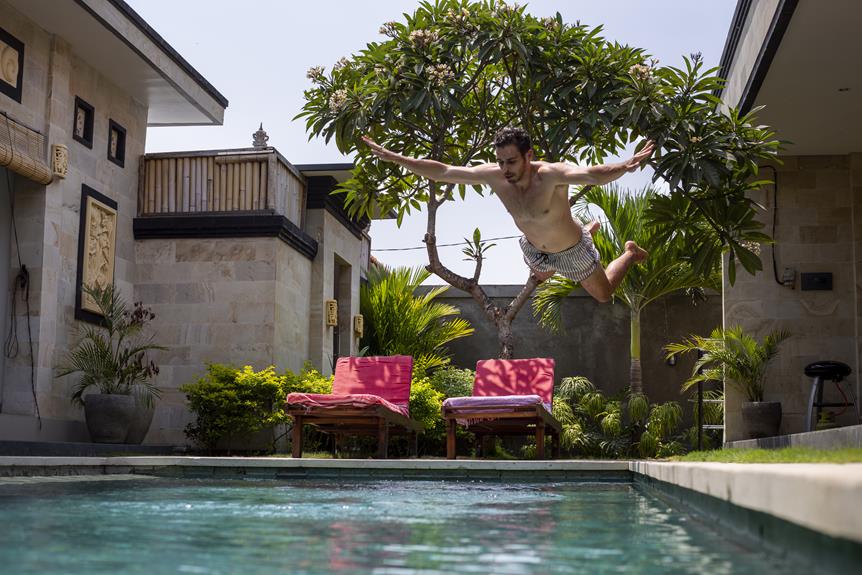Are you eager to take a refreshing dip in your pool after shocking it? Well, hold on just a moment! The waiting time before swimming depends on various factors, such as the size of your pool and the type of shock used. It’s generally safe to dive in 12-24 hours after shocking, but this can vary. Factors like the type of shock and chlorine strength can affect how quickly it dissolves. In this article, we’ll explore the ideal waiting time and the risks of swimming too soon after shocking your pool. Let’s dive in!
Key Takeaways
- It is generally safe to swim in a pool 12-24 hours after shocking it.
- The time you should wait depends on the size of the pool.
- Retest the water before swimming to ensure it is safe, checking pH levels and chlorine contents.
- Swimming too soon after shocking can damage the skin, eyes, and lungs.
Recommended Waiting Time After Pool Shocking
You should wait 12-24 hours before swimming in a pool that has been shocked. This waiting time is crucial to ensure the safety of the swimmers. When a pool is shocked, it means that a high dose of chlorine or other chemicals has been added to eliminate bacteria, algae, and other contaminants. The impact of sunlight plays a role in the waiting time. Sunlight helps break down the excess chlorine in the water, making it safe to swim in again. However, it is important to note that the time required for the chlorine levels to decrease depends on various factors such as the size of the pool and the strength of the shock treatment.
Maintaining the water balance is essential for the safety and comfort of swimmers. After shocking the pool, it is necessary to retest the water before swimming to ensure that the chlorine content and pH levels are within the recommended range. High chlorine levels can be harmful to the skin and eyes, causing itchiness, burning, and irritation. In addition, prolonged exposure to chlorinated water fumes can have adverse effects on the lungs. Swallowing highly chlorinated water can even be fatal or lead to digestive concerns.
It is also important to wait a sufficient amount of time after adding other pool chemicals before swimming. Allowing the water to cycle through the pool pump filter for 2-4 hours helps to ensure proper distribution and dilution of the chemicals. Regularly testing the pool water and maintaining a balanced chemical composition is crucial to ensure the safety and enjoyment of swimming.
Factors Affecting Pool Shock Dissolution Time
Factors affecting pool shock dissolution time can vary based on several key factors. These factors include the type of shock used, the strength of the chlorine, the size of the crystals, and even the manufacturer of the shock. It’s important to understand these factors in order to properly gauge the amount of time it will take for the shock to dissolve in your pool.
Dissolution Time Factors
The type of shock, strength of chlorine, size of crystals, and manufacturer all affect the dissolution time of pool shock. The chemical reaction time and impact on water quality are important factors to consider when determining how long to wait before swimming.
- Different types of shock have varying dissolution times.
- The strength of chlorine in the shock can affect how quickly it dissolves.
- The size of the crystals can also impact dissolution time.
- The manufacturer of the shock may have specific instructions for dissolution.
- It is important to consider the impact on water quality, as proper dissolution ensures effective treatment of the pool water.
Understanding these factors can help you make an informed decision about how long to wait before swimming after shocking your pool.
Impact of Pool Size
When considering the impact of pool size, take into account the amount of shock needed for effective treatment. The size of your pool plays a significant role in determining the recommended waiting time before swimming after pool shocking. For smaller pools, such as those under 10,000 gallons, you can typically wait around 12-24 hours before diving back in. However, for larger pools, it is generally advised to wait a bit longer, up to 24-48 hours, to ensure that the shock has thoroughly dispersed and the chlorine levels have normalized. It’s important to remember that these waiting times are just guidelines, and it’s always a good idea to retest the water before taking a dip to ensure it is safe. Now, let’s delve into the potential risks of swimming too soon after pool shocking.
Risks of Swimming Too Soon After Pool Shocking
Swimming too soon after shocking your pool can lead to damage to your skin, eyes, and lungs, as excess chlorine can cause itchiness, burning, and dehydration on the skin, eye irritation and dryness, and even lung damage with long-term exposure to chlorinated water fumes. To ensure your health and safety, it is important to take certain precautions before diving back into the water.
Here are some important safety precautions to consider:
- Wait for the appropriate amount of time: Generally, it is safe to swim in a pool 12-24 hours after shocking it. However, the exact waiting time may vary depending on the size of your pool. Larger pools may require a longer waiting period.
- Consider sunlight exposure: Strong sunlight can help speed up the breakdown of excess chlorine in the water. So, if your pool is exposed to direct sunlight, it may become safe to swim in sooner.
- Retest the water: Before jumping into the pool, it is crucial to retest the water to ensure it is safe for swimming. Check the pH levels and chlorine contents of the water to make sure they are within the recommended range.
- Dissolution time: The time it takes for pool shock to dissolve can vary. Factors such as the type of shock, strength of chlorine, size of crystals, and manufacturer can affect the dissolution process. While liquid pool shock doesn’t require dissolving, granular pool shock may take around 15 seconds to dissolve in warm water. To prevent uneven dissolution, it is advisable to pre-dissolve granular shock in warm water.
- Other chemicals: If you have added other pool chemicals, it is important to wait a few hours before swimming. Allow the water to cycle through the pool pump filter for 2-4 hours. Testing the water again after adding chemicals is crucial to ensure it is properly balanced.
Waiting Time After Adding Other Pool Chemicals
After adding other pool chemicals, it is important to wait a few hours before swimming. This allows the chemicals to fully dissolve and mix into the water, ensuring that the pool is properly balanced. Additionally, it is recommended to allow the water to cycle through the pool pump filter for 2-4 hours to further ensure chemical distribution. By testing the water before swimming, you can maintain safe chemical levels and ensure a pleasant swimming experience.
Chemical Reaction Time
The time it takes for pool shock to dissolve varies depending on factors such as the type of shock, strength of chlorine, size of crystals, and manufacturer. The effectiveness of pool shock directly impacts water clarity. Here are some key points to consider:
- Different types of shock have varying dissolution rates.
- The strength of chlorine in the shock can affect how quickly it dissolves.
- The size of the shock crystals can also impact dissolution time.
- Manufacturers may have different formulations that dissolve at different rates.
- It is important to follow the manufacturer’s instructions for proper dissolution.
Understanding these factors can help ensure that the pool shock is effectively dissolved, which in turn will have a positive impact on the clarity of the pool water.
Water Balance Importance
Maintaining proper water balance in your pool is crucial for ensuring the safety and comfort of your swimming experience. To achieve this, regular water balance testing is necessary. When it comes to pool shock safety precautions, it is important to wait before swimming after shocking your pool. The waiting time generally falls between 12-24 hours, depending on the size of your pool. Strong sunlight can aid in making the water safe to swim in again. Before taking a plunge, it is essential to retest the water to ensure it is safe by checking pH levels and chlorine contents. By following these safety precautions, you can enjoy a worry-free swimming experience. Now, let’s explore the impact of pool shock on pool equipment.
Impact on Pool Equipment?
To prevent any potential damage to your pool equipment, it’s important to be aware of the impact that pool shock can have. When you shock your pool, it can affect the water circulation and the overall maintenance of your pool equipment. Here are some key points to consider:
- Pool shock can cause an increase in chlorine levels, which can lead to corrosion and damage to your pool equipment.
- High levels of chlorine can also affect the pH balance of the water, causing further damage to your equipment.
- The shock treatment can cause debris and particles to be released into the water, which can clog filters and affect water circulation.
- It is important to regularly clean and maintain your pool equipment to prevent any build-up or blockages caused by the shock treatment.
- Proper pool equipment maintenance will ensure that your pool operates efficiently and effectively, providing you with clean and clear water.
Best Practices for Pool Shocking and Water Testing
You should wait a few hours after shocking your pool before swimming to ensure the water is safe and balanced. This is crucial for chemical safety and maintaining water clarity. After adding pool shock, it is important to give it time to dissolve and circulate throughout the water. The dissolution time of pool shock can vary depending on factors such as the type of shock, strength of chlorine, size of crystals, and manufacturer. While liquid pool shock doesn’t require dissolving, granular pool shock may take around 15 seconds to dissolve in warm water. To prevent uneven dissolution, it is recommended to pre-dissolve granular shock in warm water before adding it to the pool.
Swimming too soon after shocking the pool can pose risks to your health. Excess chlorine can cause skin irritation, itching, and dehydration. It can also lead to eye irritation, dryness, and vision problems. Inhaling chlorinated water fumes over a long period of time can damage the lungs. Swallowing highly chlorinated water can be fatal or cause digestive issues. Therefore, it is important to wait until the chlorine levels have balanced out before swimming.
In addition to waiting after shocking the pool, it is also advisable to wait a few hours after adding other chemicals before swimming. This allows the water to cycle through the pool pump filter and ensures that the chemical levels are balanced. Regularly testing the pool water is essential for maintaining safe chemical levels and ensuring a healthy swimming environment.
Now that you know the best practices for pool shocking and water testing, let’s explore alternative pool shocking products and methods that can be used to keep your pool clean and safe.
Alternative Pool Shocking Products and Methods
Now that you have a good understanding of the best practices for pool shocking and water testing, let’s explore some alternative pool shocking products and methods that you can consider. These alternatives offer different options for shock treatments and can provide additional benefits for maintaining the cleanliness and clarity of your pool water.
Here are some alternative shock products and methods to consider:
- **Potassium Peroxymonosulfate**: This is a non-chlorine shock option that can be used to oxidize contaminants in the water. It is safe to use and does not produce chloramines, which can cause eye and skin irritation. Potassium peroxymonosulfate can be a good choice for those who are sensitive to chlorine or prefer a chlorine-free option.
- **Pre-Dissolving Shock**: One of the benefits of pre-dissolving shock is that it ensures even distribution of the shock treatment throughout the pool water. By dissolving the shock in warm water before adding it to the pool, you can prevent clumping and uneven dissolution. This method also allows the shock to work more effectively and efficiently in killing bacteria, algae, and other contaminants.
- **Alternative Shock Methods**: In addition to traditional granular and liquid shock treatments, there are alternative shock methods available. These include using shock tablets, chlorine generator systems, or even saltwater chlorination systems. These methods offer convenience and ease of use, as well as various benefits such as reduced chlorine smell and improved water quality.
- **Non-Chlorine Shock Options**: If you prefer to minimize your use of chlorine while still effectively shocking your pool, there are non-chlorine shock options available. These products typically use alternative oxidizers like potassium monopersulfate or hydrogen peroxide to sanitize and clarify the pool water. Non-chlorine shock treatments can be a great choice for those looking for less chemical exposure.
- **Eco-Friendly Shocking Products**: For those who are conscious about the environmental impact of pool chemicals, there are eco-friendly shock options available. These products are typically made from natural ingredients and are designed to be safe for the environment while still effectively treating your pool water.
Additional Resources for Pool Maintenance and Safety
If you’re looking for more information on pool maintenance and safety, there are additional resources available to help you. When it comes to pool safety, it’s important to stay informed and educated about best practices. Whether you’re a pool owner or simply someone who enjoys swimming, having access to reliable resources can make a big difference in keeping your pool safe and well-maintained.
One valuable resource for pool safety is the Centers for Disease Control and Prevention (CDC). They offer a wealth of information on pool safety guidelines, including tips for preventing drowning, avoiding recreational water illnesses, and maintaining proper water chemistry. Their website provides detailed resources and educational materials that can help you ensure the safety of your pool.
The National Swimming Pool Foundation (NSPF) is another great resource for pool maintenance. They offer various online courses and certifications that cover topics like water chemistry, pool operation, and safety. By taking these courses, you can gain a deeper understanding of pool maintenance practices and learn how to create a safe swimming environment.
Additionally, local pool supply stores often have knowledgeable staff who can provide guidance on pool safety and maintenance. They can assist you in selecting the right products and offer advice on how to properly maintain your pool.
Frequently Asked Questions
Can I Swim in the Pool Immediately After Shocking It?
You should not swim in the pool immediately after shocking it. It is important to wait for a specific amount of time to ensure your safety. Swimming too soon after shocking can put you at risk for skin and eye irritation, as well as potential lung damage from chlorine fumes. It is best to wait for 12-24 hours before swimming, depending on the size of your pool. Always test the water before swimming to ensure it is safe.
How Long Does It Take for Liquid Pool Shock to Dissolve?
Liquid pool shock dissolves quickly, taking about 15 seconds in warm water. But let’s not dive right into the swimming question just yet. It’s important to understand the dissolution time of pool shock to ensure its effectiveness. Factors like the type of shock, chlorine strength, crystal size, and manufacturer can affect dissolution. Pre-dissolving granular shock in warm water can prevent uneven dissolution. Now that we’ve clarified that, let’s explore the question of when it’s safe to take a dip after shocking your pool.
Is It Safe to Swim in the Pool if the Shock Hasn’t Fully Dissolved?
It’s important to prioritize swimming precautions and proper pool shocking. While waiting time after shocking the pool can vary, it’s generally safe to swim in a pool 12-24 hours after shocking it. However, before jumping in, ensure the shock has fully dissolved. Swimming too soon can put you at risk of skin, eye, and lung damage. So, take the time to let the shock dissolve completely and retest the water to ensure it’s safe for swimming.
Can I Add Other Pool Chemicals Immediately After Shocking the Pool?
After shocking your pool, it’s important to wait before adding other chemicals. Adding chemicals immediately can disrupt the balance and effectiveness of the shock treatment. Give it a few hours for the shock to fully dissolve and circulate through the pool. This waiting period allows the shock to do its job and ensures the water is safe for swimming. Remember to test the water before adding any additional chemicals to maintain the proper balance.
Are There Any Alternative Methods for Pool Shocking That Are Safer or More Effective?
Alternative methods for pool shocking include using potassium peroxymonosulfate. This option is safer and more effective for some pool owners. Benefits of using alternative pool shocking methods include less skin and eye irritation, as well as reduced lung and digestive concerns. Potassium peroxymonosulfate is a non-chlorine shock that can be used without waiting for it to dissolve. However, always follow the manufacturer’s instructions and test the water before swimming to ensure it is safe.
Conclusion
In conclusion, taking the time to wait before swimming in your pool after shocking it is crucial for your safety and enjoyment. Factors such as the type of shock and pool size can affect the dissolution time, so it’s important to be patient. Swimming too soon can lead to skin and eye irritation, lung damage, and digestive concerns. By following best practices, maintaining proper chemical levels, and exploring alternative methods, you can ensure a safe and refreshing swimming experience all summer long.




